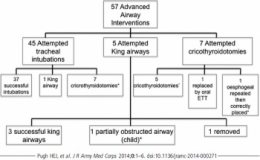IOT: Affaire de tous et pas de spécialiste
12/11/2015
A review of pre-admission advanced airway management in combat casualties, Helmand Province 2013
Pugh HEJ, et al. J R Army Med Corps 2014;0:1–6. doi:10.1136/jramc-2014-000271
--------------------------------------
Parmi les enjeux de la médicalisation de l'avant, ou en d'autres termes du prolonged field care, il y a la maîtrise de la gestion des voies aériennes, notamment l'intubation et la coniotome. Ce document qui analyse tous les blessés ayant bénéficié d'une manoeuvre avancée avant leur prise en charge au role 3 de Camp Bastion.Très clairement la prise en charge des blessés par des personnels expert de part leur emploi en UK permet l'obtention de 100 % de réussite alors que ce geste conduit par les équipes US n'atteint un taux de succès que de 64%. Les équipes UK n'ont pas eu besoin d'avoir recours à la coniotomie. Cette dernière est réalisée à 14 reprises par les équipes US avec 1 seul échec vrai. Les vraies complications étaient une intubation sélective à 3 reprises et un placement oesophagien. Notons la place relativement restreinte du tube laryngé de King. Une fois de plus il faut insister sur la nécessité de maîtrise de l'abord trachéal par tout personnel médical. Alors si cette éventualité n'est pas fréquente, les conditions actuelles avec les éloignements et la durée des MEDEVAC font qu'acquérir et entretenir cette maîtrise est fondamental et que chacun soit conscient de cette nécessité.
--------------------------------------
Objectives
Airway compromise is the third leading cause of potentially preventable combat death. Pre-hospital airway management has lower success rates than in hospital. This study reviewed advanced airway management focusing on cricothyroidotomies and supraglottic airway devices in combat casualties prior to admission to a Role 3 Hospital in Afghanistan.
Methods
This was a retrospective review of all casualties who required advanced airway management prior to arrival at the Role 3 Hospital, Bastion, Helmand Province over a 30-week period identified by the US Joint Theatre Trauma Registry. The notes and relevant X-rays were analysed. The opinions of US and UK clinical Subject Matter Experts (SME) were then sought.
Results
Fifty-seven advanced airway interventions were identified. 45 casualties had attempted intubations, 37 (82%) were successful and of those who had failed intubations, one had a King LT Airway (supraglottic device) and seven had a rescue cricothyroidotomy. The other initial advanced airway interventions were five attempted King LT airways and seven attempted cricothyroidotomies. In total, 14 cricothyroidotomies were performed; in this group, there were nine complications/significant events.
Conclusions
The SMEs suggested that dedicated surgical airway kits should be used and students in training should be taught to secure the cricothyroidotomy tube as well as how to insert it. This review re-emphasises the need to "ensure the right person, with the right equipment and the right training, is present at the right time if we are to improve the survival of patients with airway compromise on the battlefield".



Les commentaires sont fermés.